Eating a healthy diet is one of the best ways to take care of yourself and prevent illness. Unfortunately, most Americans get too many calories and not enough fiber in their diet. Busy lifestyles, desk jobs, fast foods, video games, and personal computers have led many Americans to a less healthy diet, and a less active day. Because of this, America is less fit than ever before. More than 60% of Americans are overweight, and the U.S. Surgeon General has declared that Obesity is now an epidemic.
Excess weight causes a number of health problems, including high blood pressure, high cholesterol, diabetes, arthritis, and heart attacks. A healthy diet can help you lose weight, lower your cholesterol, lower your risk of cancer and heart disease, and maintain regularity.
A healthy diet is balanced, containing foods from each of the following groups:
Most of the extreme or fad diets are lacking in nutrition. For example, an all-vegetarian diet has no vitamin B-12, and tends to lack essential amino acids, and therefore it is not recommended. Those who choose a vegetarian diet for reasons other than health need to eat fish twice a week. People who cannot eat dairy products need to take calcium supplements such as OsCal or Tums every day. Anyone on a diet that is not well balanced needs to take one multivitamin every day.
- Grains (foods made from wheat, rice, bran, oats, etc., such as bread, cereal, pasta, etc.)
- Fruits & Vegetables
- Protein (meat, fish, eggs, etc.)
- Dairy (milk, cheese, etc.).
Within each of the above food groups, there are healthy choices. For example, skim milk has less fat than whole milk or ice cream. Fish and poultry have less fat than red meat. Other than avocados, all fruits and vegetables are excellent, low fat sources of fiber. Among grains, whole wheat and bran have more fiber than white bread and white flour pasta.
The old food pyramid of the 1970's implied that all fat was bad. Today, we know that plant oils (a type of fat) are healthy, animal fats (e.g. butter and the fat around red meat) are less healthy, and all "hydrogenated" fats are unhealthy, even though all types of fat contain calories. The old food pyramid should be replaced with the following new food pyramid.
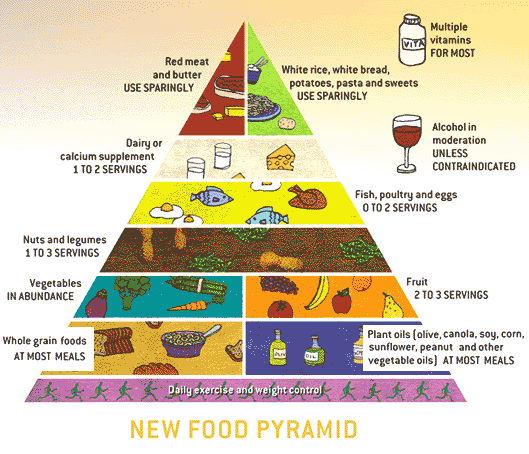
Source: Eat, Drink, And Be Healthy, Walter C. Willett, 2001.
The low fat diets that are recommended by many American cardiologists are effective diets for weight loss and health improvement when they are followed closely. However, following them closely can taste like a diet of cardboard. Therefore, I prefer the Mediterranean Diet, which is also a healthy diet, and is better tasting and therefore easier to follow.
To change your diet, you can start with your current diet, and gradually add foods from the groups that have been missing. Slowly increase your intake of fish, fruits, vegetables, skim milk, and whole grains (bran, whole wheat, shredded wheat, etc.) over time. At the same time, gradually decrease your intake of fried foods, white bread, and candy. As you add more healthy foods to your diet, try to eat less of the other, unhealthy foods. The gradual changes that you make over time will facilitate a lifetime of healthier eating.
Losing Weight
Maintaining a healthy weight will help you avoid problems like high blood pressure, high cholesterol, diabetes, arthritis, and heart attacks. And it will maximize the number of life's activities that you can participate in.
For most people, losing weight is a process rather than an event. The process of losing weight involves changing some of your behaviors. The following steps are recommended:
The Weight Watchers program can help you with all of these steps. It is best program that I have seen. Weight Watchers can provide you with the education and support that you need to lose weight and keep it off.
- Learn about foods and calories.
- Learn about a few types of exercise.
- Believe that you can lose weight.
- Decide how you can realistically maintain a decreased intake of calories and/or an increased amount of physical activity.
- Put your plan into practice.
- Weigh yourself weekly to monitor your progress.
- Get help if you are having trouble.
- When you have lost the desired amount of weight, continue the healthy habits you have acquired so that you can stay at your desired weight throughout your life.
For those who wish to lose weight on their own, there are a number of diets available. Two of the most popular and useful ones are pictured below.
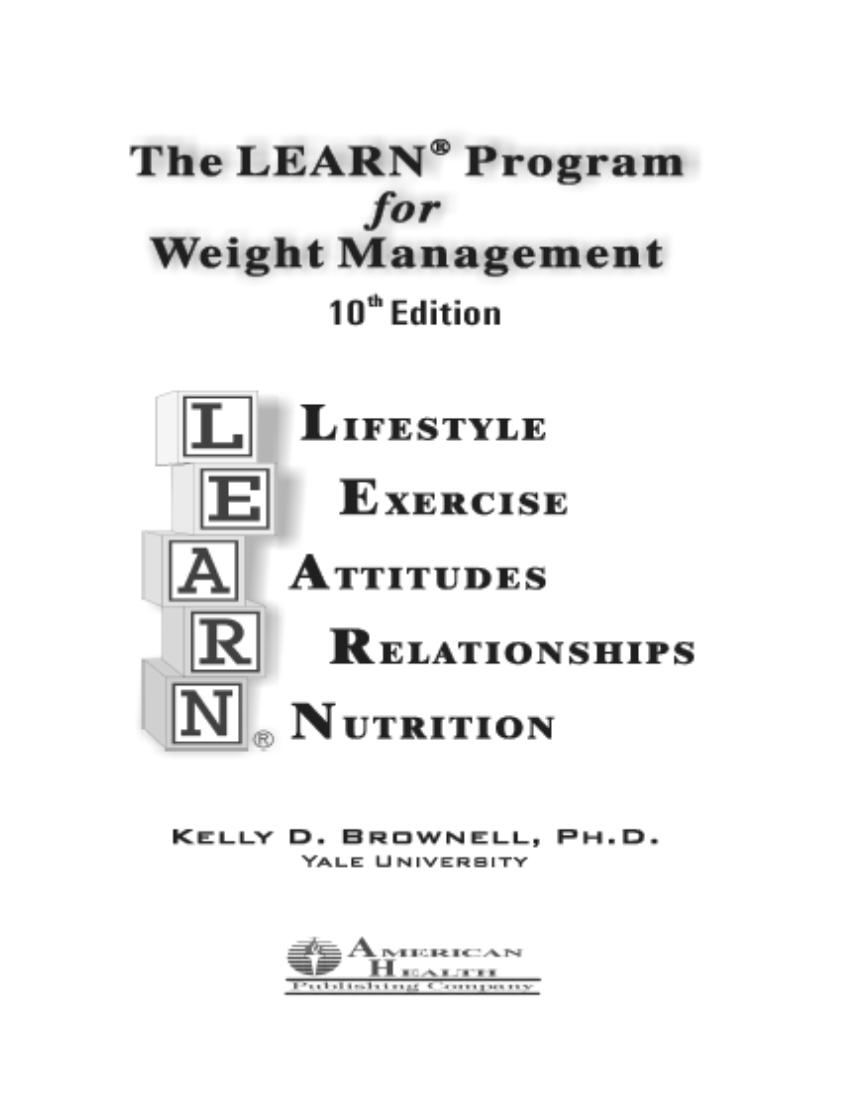 The Standard Lowfat Diet prescribed by doctors for many years is described in Kelly Brownell's book entitled LEARN. The Standard Lowfat Diet prescribed by doctors for many years is described in Kelly Brownell's book entitled LEARN. LEARN is an acronym that stands for the five essential components of our lifestyle behavior-change programs: Lifestyle, Exercise, Attitudes, Relationships, and Nutrition. These components are important because lifestyle change encompasses much more than changing just one specific area of your life—it embraces everything about you. Lifestyle is, after all, everything about the way we live. It embraces everything from our most private thoughts to our overt behaviors. Lifestyle is the interaction of our thoughts, feelings, behaviors, attitudes, goals, and personal values. It is reflected in how we feel about ourselves and in our relationships and environment. The unique thoughts, feelings, and behaviors that most directly affect us are part of the greater fabric of lifestyle. We can no more focus on changing one isolated behavior than we can isolate a single thread in a tightly woven blanket, change that thread, and say we have a new blanket. Just as the blanket is composed of tightly interwoven threads, so is the fabric of life and lifestyle. The complex interwoven fabric of life comprises all that we are—to change one behavior, we must address all of the threads. The lifestyle approach emphasizes gradual, sustainable, and permanent changes in lifestyle, exercise, attitude, relationships, and nutrition. |
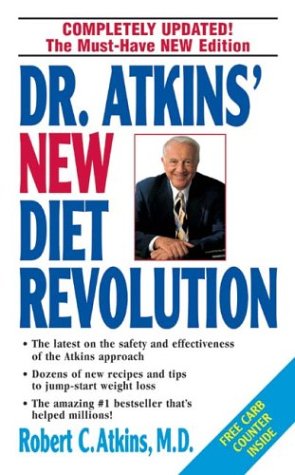 The Atkins Diet is a high-fat, low-carbohydrate, alternative diet that may be more effective and just as safe as the standard low-fat diet, but has not been studied enough to know for sure. Most people feel that it is safe and effective. The Atkins Diet is a high-fat, low-carbohydrate, alternative diet that may be more effective and just as safe as the standard low-fat diet, but has not been studied enough to know for sure. Most people feel that it is safe and effective.Amazon.com Editorial Review Designed to catapult your body into a state of fat meltdown, Dr. Atkins's diet has taken America by storm. It targets insulin, the hormone that regulates blood sugar levels. The bodies of most overeaters are continually in a state of hyperinsulinism; their bodies are so adept at releasing insulin to help convert excess carbohydrates to fat that there's always too much of the hormone circulating through the body. This puts the body into a bind; it always wants to store fat. Even when people with hyperinsulinism try to lose weight--especially when they cut fat but increase carbohydrate consumption--their efforts will fail. This is why Dr. Atkins refers to insulin as "the fat-producing hormone." Dr. Atkins's diet is extremely low in carbohydrates, which helps to regulate insulin production and decrease circulating insulin; less insulin soon results in less fat storage and fewer food cravings. The diet is far from torturous, though--those who've tried it attest that hunger is not a part of this plan. Ninety percent of Dr. Atkins's patients--more than 25,000 of them--have experienced dramatic weight loss. The book includes recipes for such luscious, low-carb dishes as lobster soup, zabaglione, sea bass, and blueberry ice cream, and even includes a carbohydrate gram counter and menus. |
Food Addiction
If you have tried all of the above steps, and you are unable to stick to a diet, you may have a different kind of problem. Try asking yourself these questions:
If you answered yes to any of these questions, you may be Addicted to Food. If you are addicted to food, you are not alone. There are others who have this condition, and many have recovered from it. Treatments for this condition include the following:
- Do you find yourself eating for reasons other than hunger, such as loneliness, depression, or stress?
- Do you feel that food is your friend?
- Do you spend a lot of time thinking about food?
- Are you more than 100 pounds overweight?
- Do you have feelings of guilt and remorse after eating?
You can learn more about Food Addiction by going to the Overeaters Anonymous web site. Also, the following two books are highly recommended.
- Reading a book on Food Addiction (see below).
- The Overeaters Anonymous program.
- Professional Counseling for an Eating Disorder.
- In some cases, medication, such as Effexor or Metformin.
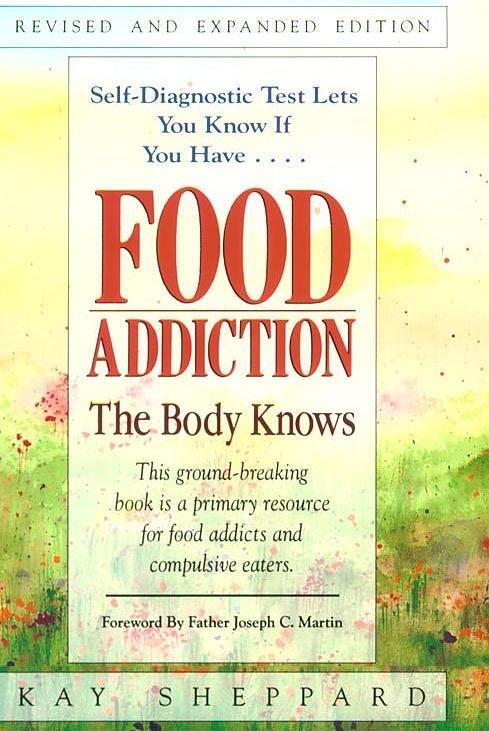 Since
its publication four years ago, Food Addiction has become a
primary resource for food addicts and compulsive eaters. Now it
is updated and presented in a revised and expanded edition, with a new
chapter on relapse. For a food addict, relapse is
an ever present danger which begins in the mind before reaching for
that cupcake or other trigger food. Since
its publication four years ago, Food Addiction has become a
primary resource for food addicts and compulsive eaters. Now it
is updated and presented in a revised and expanded edition, with a new
chapter on relapse. For a food addict, relapse is
an ever present danger which begins in the mind before reaching for
that cupcake or other trigger food. Here food addiction is defined, trigger food are identified and consequences of food addiction are revealed. A lifetime eating plan is presented, which demonstrates how to stick with a healthful food plan for the long term. "For some people, food can be as effective as alcohol," Kay Sheppard tells us. "Gummy bears and marshmallow chicks can be vicious killers whose effects can lead to depression, irritability and even suicide. The terrible truth is that for certain individuals, refined carbohydrates can trigger the addictive process. This book is an effort to help you understand and solve the problems of compulsive eating." |
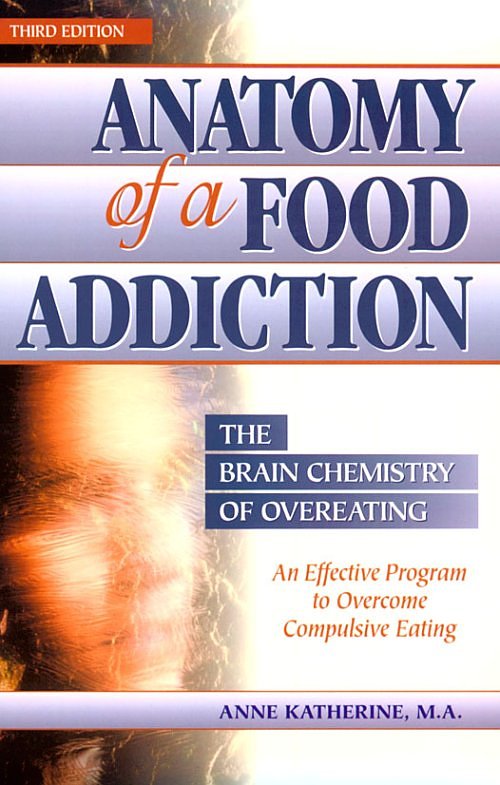 HOPE,
HELP, AND A REAL EXPLANATION FOR THE DISEASE OF FOOD ADDICTION HOPE,
HELP, AND A REAL EXPLANATION FOR THE DISEASE OF FOOD ADDICTIONIf you have struggled with binge eating, compulsive eating, dieting, and the guilt and conflict they bring, your life will be changed by this important, life affirming, and astonishingly wise book. Anne Katherine, a Certified Eating Disorders Therapist and recovering food addict, explains the chemical reactions in the brain that work in conjunction with lifelong emotional conflicts to make certain foods--particularly sugar and refined carbohydrates--so comforting that they are almost like a drug. Once you realize that your binge eating is a physical disease that can be treated, you can use the book's self-tests, exercises, examination of family issues, and complete recovery program for newfound understanding and confidence. The rewards of recovery are astounding, abundant and life-changing. |
www.DoctorPaddock.com